Painted Turtle
Chrysemys picta
Male painted turtles have longer nails.
Advertisement
Painted Turtle Scientific Classification
- Kingdom
- Animalia
- Phylum
- Chordata
- Class
- Reptilia
- Order
- Testudines
- Family
- Emydidae
- Genus
- Chrysemys
- Scientific Name
- Chrysemys picta
Read our Complete Guide to Classification of Animals.
Painted Turtle Conservation Status
Painted Turtle Facts
- Prey
- insects, small fish, small mammals, crustaceans
- Name Of Young
- hatchling
- Group Behavior
- Group
- Fun Fact
- Male painted turtles have longer nails.
- Biggest Threat
- Habitat reduction
- Most Distinctive Feature
- colorful stripes on legs and neck
- Other Name(s)
- Western, eastern, midland, and southern painted turtle
- Gestation Period
- 80 days
- Litter Size
- 4-10
- Habitat
- Ponds, streams, marshes
- Predators
- Raccoons, otters, foxes
- Diet
- Omnivore
- Type
- Reptile
- Common Name
- Painted turtle
- Group
- large groups
View all of the Painted Turtle images!
Painted turtles have an incredibly long lifespan and can get as old as 50 years.
The painted turtle is North America‘s most common type of aquatic turtle. These adorable small reptiles have wide shells, dark skin, and colorful stripes across their legs and neck. Whether they’re living together in a shallow pond or enjoying domestic life as a pet, these turtles are a wonderful part of the Western hemisphere’s ecosystem.
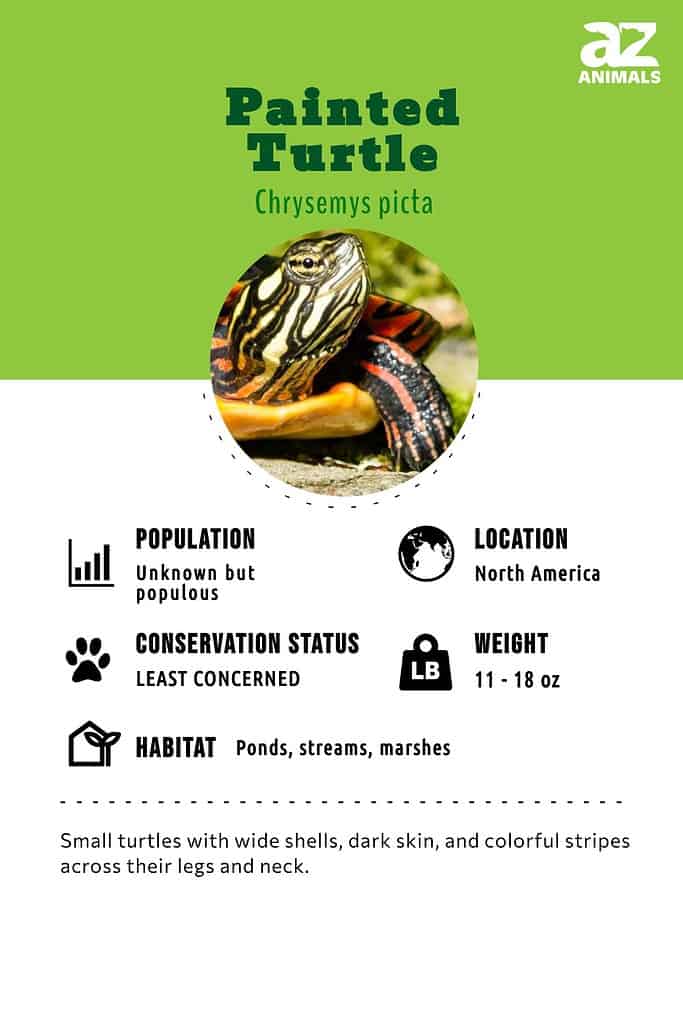
5 Incredible Painted Turtle Facts!
- Male-painted turtles have longer nails. These nails are typically used during the courtship process; the male gently caresses the female’s head, and she decides if she wants to spend more time with him.
- Like most turtle species, painted turtles abandon their eggs after nesting. Baby turtles are expected to make their own way to the water, where they will learn to survive as part of the group.
- The gender of a painted turtle egg is determined by temperature. If the eggs are incubated above 84 degrees Fahrenheit, they will come out female instead of male.
- Painted turtles spend almost all of their time underwater – except when they are basking in the sun, which they often do for several hours a day.
- The painted turtle is the most common aquatic turtle species in North America. You can find these adorable fellows in ponds and streams across the entire continent.
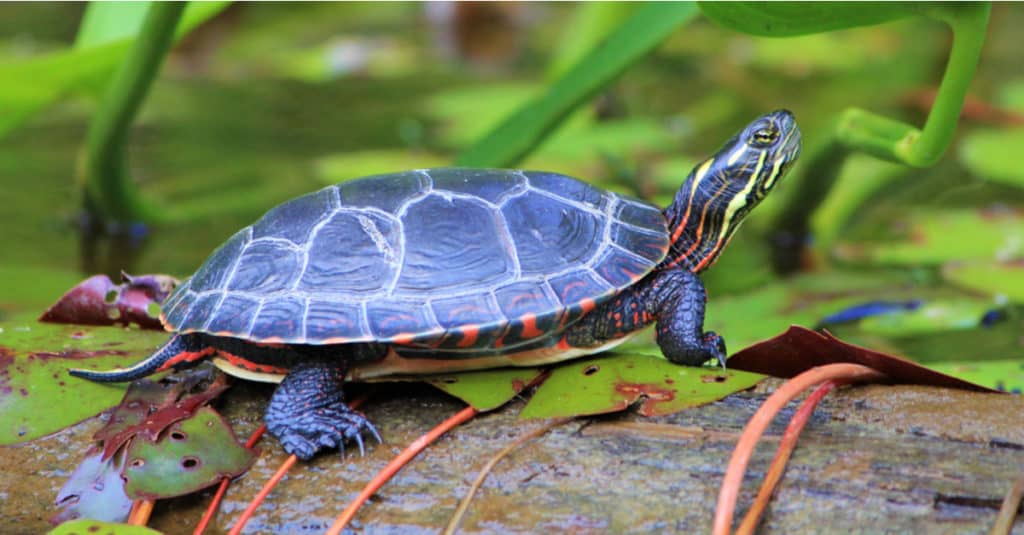
Painted turtles can be seen in ponds and streams all across North America.
©Sketchart/Shutterstock.com
Scientific Name
The scientific name for the painted turtle is Chrysemys picta. The genus Chrysemys is named after the Greek words “chrysos”, or “gold,” and “emys”, or “water tortoise.” Meanwhile, the word “picta” means “painted.” These turtles are members of the Reptilia class and the Emydidae family.
Species
- Painted turtle (Chrysemys picta) – This turtle is native to North America and lives in slow-moving waters from southern Canada to northern Mexico and across the United States from sea to sea.
- Southern painted turtle (Chrysemys dorsalis) – this former subspecies was elevated after DNA evidence showed that geographic isolation led the turtle to become distinct enough to warrant species status. The Southern painted turtle is endemic to the south-central United States.
Evolution
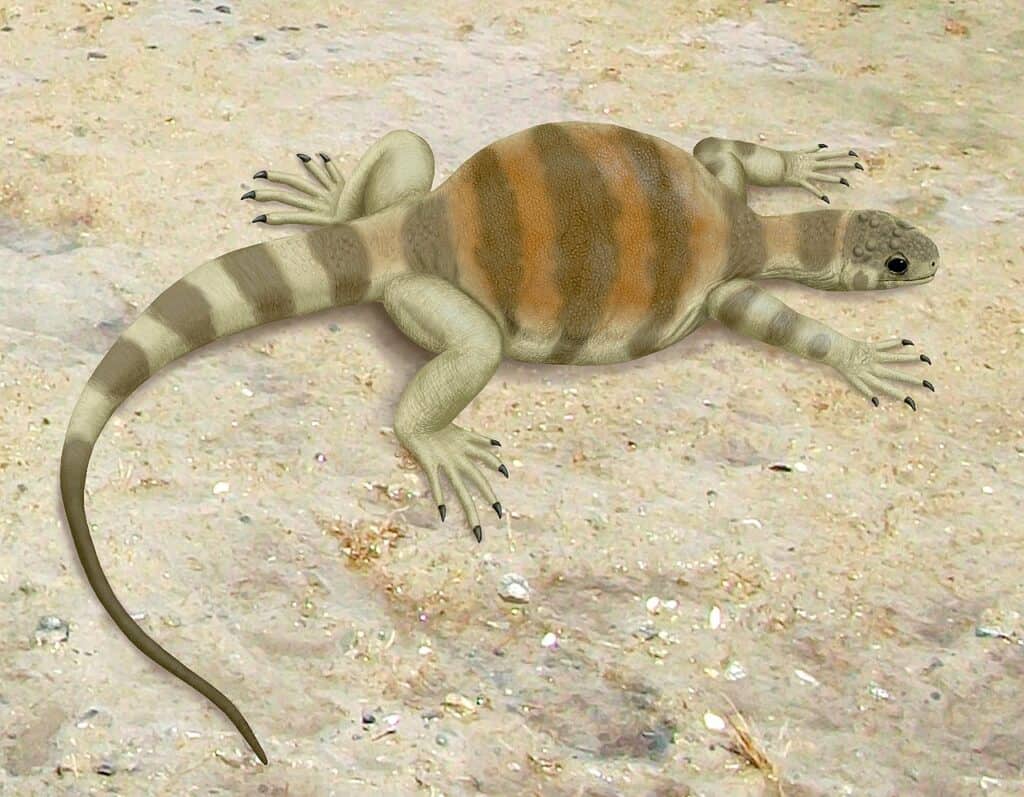
is the earliest ancestor of modern turtles and existed 260 million years ago.
©Smokeybjb / CC BY-SA 3.0 – License
The earliest known ancestor of modern turtles was Eunotosaurus, a reptile that existed during the Permian epoch, around 260 million years ago. Eunotosaurus didn’t have a shell but did have the framing for one with wide ribs that shielded the animal’s underside. Recent studies reveal that those wide ribs aided the animal in digging and burrowing by anchoring it to the ground. Eunotosaurus had evolved to be an efficient excavator. The animal was once thought to be a swimmer but the big claws and thick bones would have helped it to withstand compressive forces while burrowing. The powerful, back-facing front limbs and weaker back limbs indicated a master burrower.
Eunotosaurus fossils have been found in what is now, South Africa, and this turtle relative lived during a period when the land was dry and arid. The animal may have evolved its burrowing ability to escape droughts. Boney rings around Eunotosaurus’s eyes indicate that it may have spent a lot of time underground.
Pappochelys and Odontochelys also seemed to be equipped with digging abilities. It is believed that after the digging adaptations were made – many turtles became aquatic. Over time, complete shells formed from the wide ribcage, perhaps to protect the slow-moving turtles hampered by broad ribs from predators. Digging platforms evolved into suits of armor. Fossils show that the painted turtle existed 15 million years ago and had adapted to aquatic life.
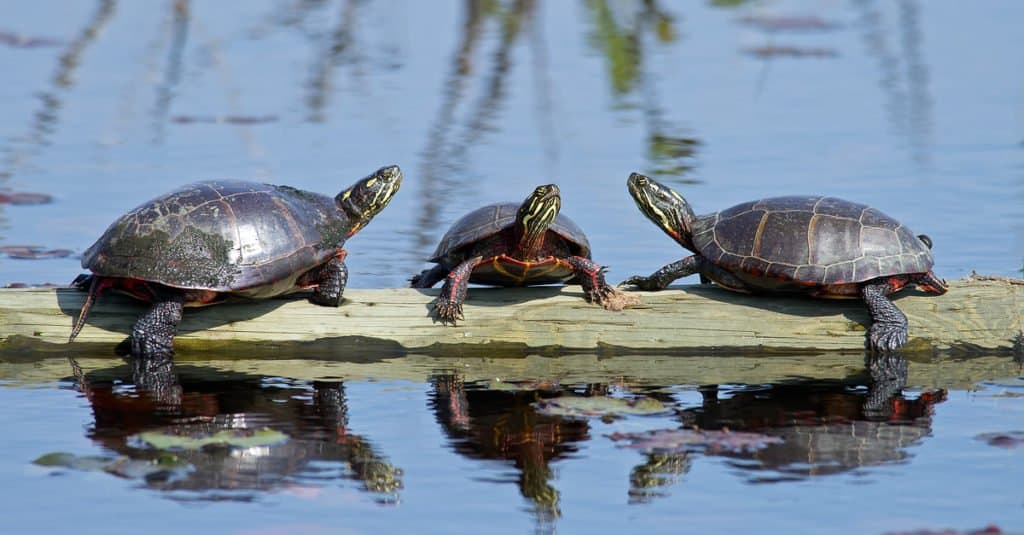
Painted turtles live in large groups and are known to be friendly toward humans.
©Brian E Kushner/Shutterstock.com
Appearance and Behavior
These turtles are freshwater turtles with either olive or black skin. In addition to their main coloring, these turtles typically have orange, yellow, or red stripes on their legs, neck, and tail. Most painted turtles weigh between 11-18 ounces. Females of this species are significantly larger than the males; while females can grow to be up to 12 inches long, males usually only get up to 8 inches long at the most.
One of the characteristic features of this turtle is that its shell is usually wider than it is long, giving it a rounded shape that is immediately recognizable. Some painted turtles have jet-black shells, while others have mild amounts of color lining the rim. Western turtles have dark-green shells with bright colors on the bottom, which is called the plastron. Meanwhile, Southern and Eastern painted turtles have solid yellow plastrons. Midland-painted turtles have a black spot in the middle of their plastron, while the rest of it is usually a deep orange.

Painted turtles prefer slow-moving streams or ponds with muddy bottoms.
©KARI K/Shutterstock.com
In the wild, these turtles live in large groups in shallow ponds or streams. They spend their time either basking in the sun, swimming in the water, or resting at the bottom of the pond. Painted turtles are docile and engaging; in many cases, they won’t be afraid to venture out of the water to interact with a human.
Habitat
These turtles live all across North America. You can usually find them in ponds, marshes, slow-moving streams, and any other source of water that won’t sweep these little reptiles away. In order to be ideal, the water source must have a muddy bottom where the turtle can hide and must be warm enough to maintain the turtle’s internal body temperature.
The various subspecies of these turtles are determined by their geographical location. Western painted turtles are typically found between Ontario and British Columbia, although they can also be found throughout the northern regions of the United States. Eastern painted turtles are located across the east coast but aren’t usually found past the Appalachian mountains. Meanwhile, the Southern painted turtle can be found anywhere in the deep south, including states like Mississippi, Missouri, and Alabama. Most of the differences between these turtle subspecies are largely aesthetic, as all painted turtles need the same conditions in which to live.
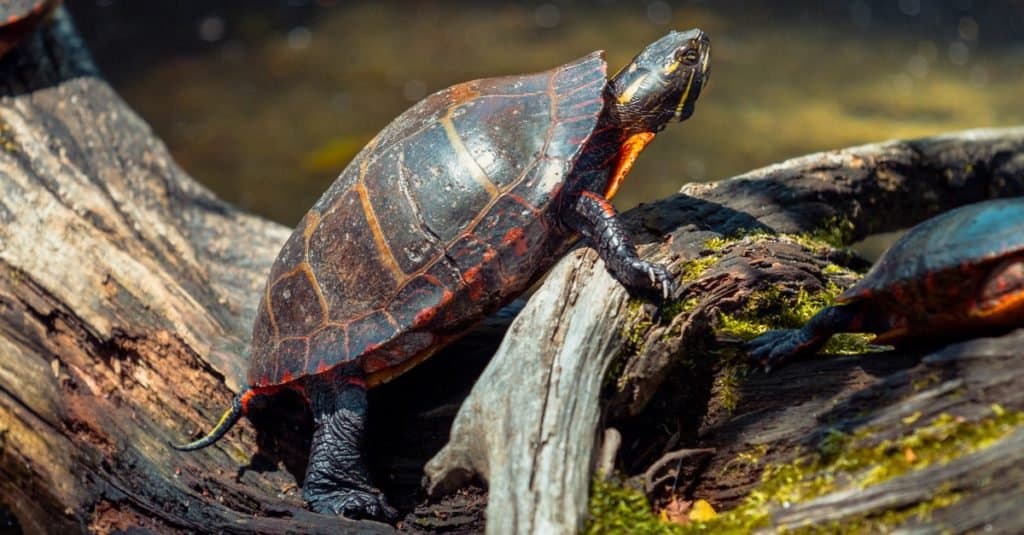
Painted turtles bask in the sun for five to six hours a day.
©Jonathan Novack/Shutterstock.com
When in their natural environment, these turtles survive by eating small fish and aquatic insects, munching on nearby vegetation, and basking in the sunshine for several hours a day. When they’re not on the surface, you can find these turtles tunneling in the mud beneath the water. Don’t expect to see the turtles in water that is too cold, moves too fast, or doesn’t have enough food to support an entire group of these friendly reptiles.
Diet
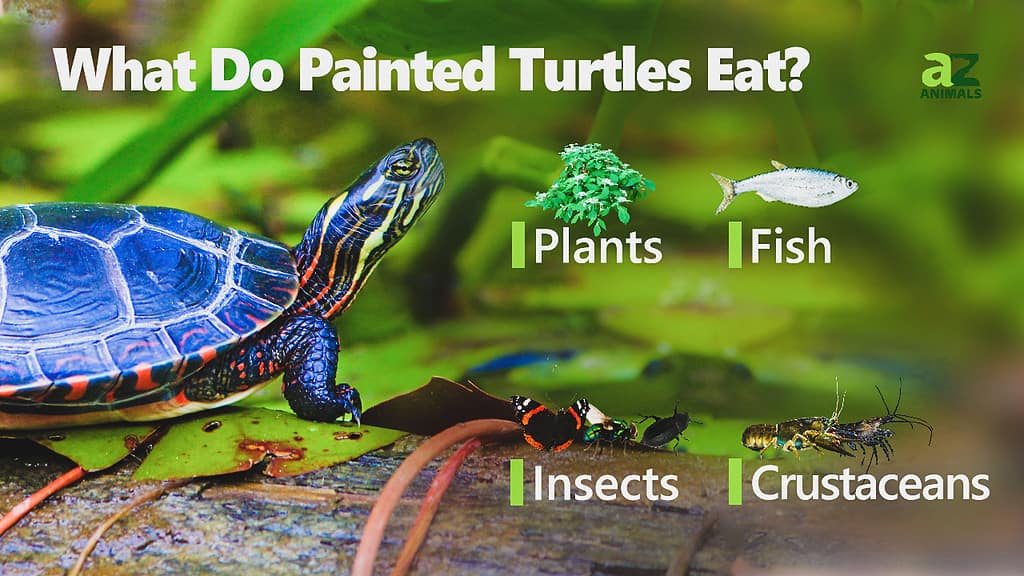
These turtles are omnivores that eat everything from insects and small fish to nearby vegetation and even carrion. A turtle’s diet often consists of a healthy mix of protein and fiber cobbled together out of whatever is available in the area. Painted turtles are expert aquatic hunters and will snap anything bite-sized out of the water. You can also expect to see turtles munching on plants or eating water algae to satisfy their nutritional requirements.
To discover the full nutritional needs of painted turtles, give our complete guide ‘What Do Painted Turtles Eat? 20+ Foods They Thrive On’ a read.
Predators and Threats
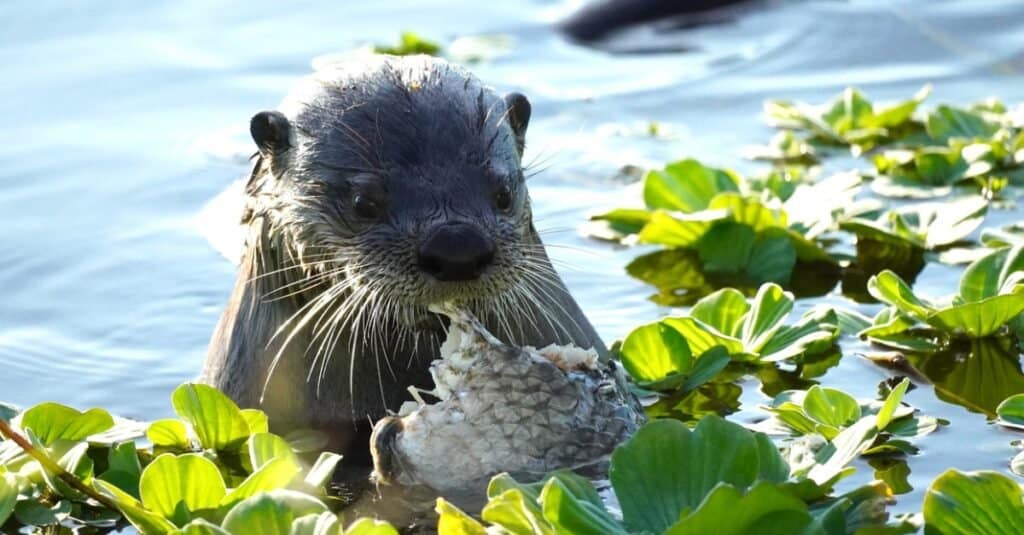
Otters prey on painted turtles.
©iStock.com/Troy Levengood
The main predators that these turtles are concerned about include otters, raccoons, foxes, and other medium-sized carnivores and omnivores. Birds of prey may also occasionally catch painted turtles. However, in general, adult painted turtles are not particularly at risk; instead, most local threats are to unguarded nests of turtle eggs. Nearly any omnivore in the area will dig up one of these nests to eat the eggs inside. In some cases, as much as 90% of the eggs from a breeding season will be lost in this way.
Aside from the normal fear of predators, modern painted turtles also have to deal with environmental destruction. As more water sources are polluted or paved over, there have been fewer places for this species to live. Currently, the species is incredibly numerous and is not at risk, but conservationists are keeping an eye on the species. Another major potential threat is pet collection; if you purchase a painted turtle from the store, check to see whether it was bred in captivity or caught in the wild.
Reproduction, Babies, and Lifespan
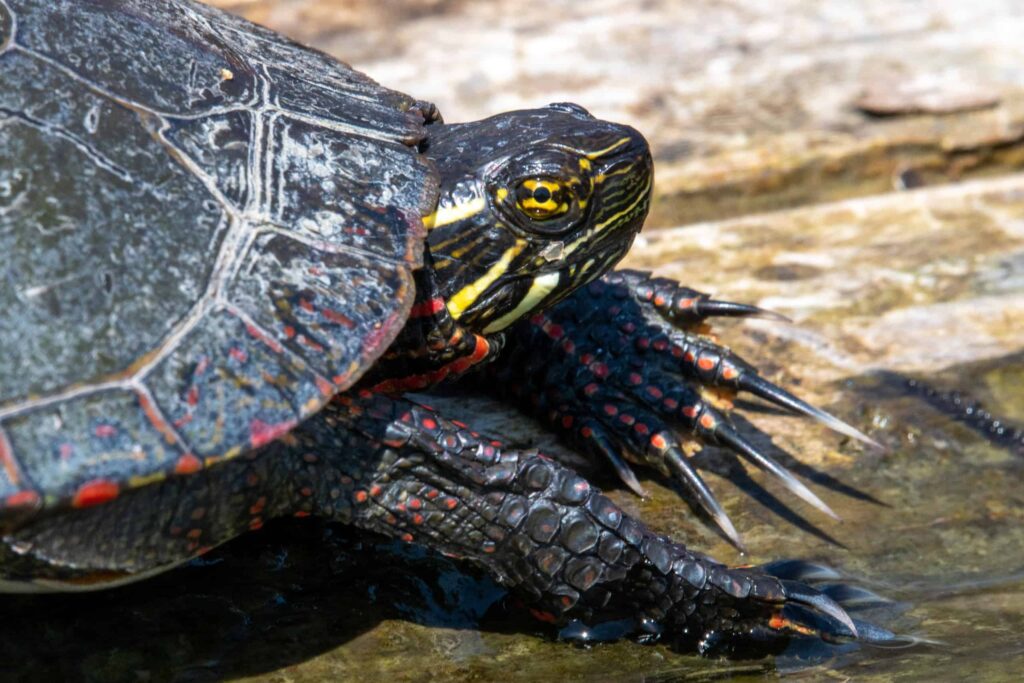
Male painted turtles have long claws that they use to show affection to potential mates.
©Lindaimke/Shutterstock.com
These turtles mate when the weather starts to warm up in the spring. A male painted turtle will typically follow a female that he is interested in. Once the two have a moment together, the male will gently stroke the female’s head with his long nails. If she reciprocates his affections, she will return the gesture, and the two will eventually sink to the bottom of the pond. Female turtles may collect sperm from multiple male partners before they begin laying their eggs.
Once mating is complete, female turtles head to the surface and begin nesting in the sand or mud near the water’s edge. Nests have been known to be hidden as far as 660 yards from the water, although they are usually significantly closer. Female turtles can lay between 2 to 5 clutches of eggs a year. When the eggs are laid, the turtle will cover them with a light layer of dirt before abandoning the clutch completely.

Painted turtle hatchlings head for the water as soon as they break out of the egg.
©Attila N/Shutterstock.com
The turtle eggs take about 80 days to incubate. If the weather is nice, the baby turtles might head to the water’s edge; otherwise, they’ll stay in their nest until the winter season has passed. Hatchlings grow quickly after they emerge from the next and can double their size within a year. These turtles are not ready to mate until they are at least 4 years of age; some subspecies do not mate until they are between 7 to 16 years old. This incredibly long-lived species has an average lifespan of 20-30 years, but some turtles have been known to get as old as 50.
Population
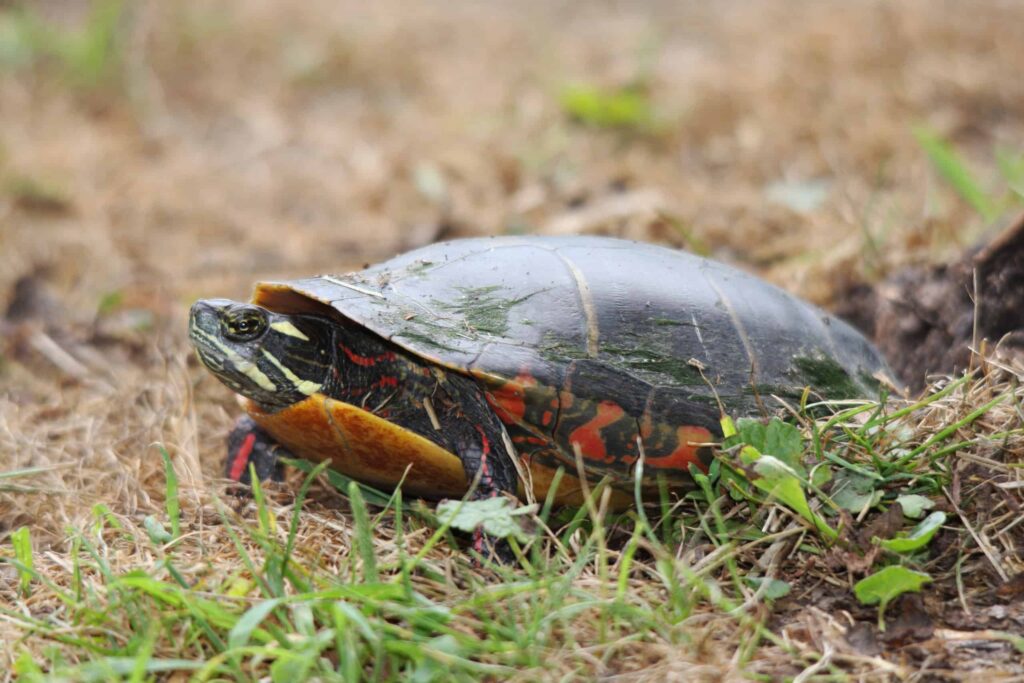
Female painted turtles lay their eggs on the ground near the water.
©Joseph M. Arseneau/Shutterstock.com
These turtles are incredibly common in North America. All various subspecies, including the Western, Southern, Eastern, and Midland painted turtles are currently listed as of least concern.
With that said, researchers have shown that there has been a decline in painted turtle populations over the last few decades. Although there is currently no cause for alarm, there has been a marked decrease in suitable habitats. When combined with threats like roadkill and pet collection, conservationists suggest that locals should start being aware of the impact their actions have on their painted turtle neighbors.
View all 192 animals that start with PPainted Turtle FAQs (Frequently Asked Questions)
Are painted turtles carnivores, herbivores, or omnivores?
Painted turtles are omnivores that will eat insects, small animals, fish, and vegetation. If you own a painted turtle, you can feed them turtle pellets, but they’ll also need their diet supplemented with actual bugs or meat and leafy vegetables.
Are painted turtles good pets?
Painted turtles are sweet and friendly animals that can make good pets. However, these particular animals require a lot of extra care and attention, especially when it comes to curating their housing and keeping it clean. If you’re capable of taking care of tank animals and helping them thrive, painted turtles are a good choice. But if you’re worried about having enough time, energy, or money to keep the tank clean, you should consider adopting an easier pet to care for.
Do painted turtles bite?
Painted turtles are known to bite, especially if they are startled or irritated. However, because they have such small jaws, it’s rare for a turtle bite to do any serious damage. Most turtles won’t bite unless something is wrong, so never assume that your turtle has an attitude problem. Instead, check to see if they are injured or otherwise have a good reason to be afraid of your fingers.
Are painted turtles safe around kids?
Painted turtles are docile pets that make good tank companions for adults. However, because they require a lot of care and are known to bite when irritated, these animals are a bad choice as pets for children. Never let an unsupervised child handle a painted turtle, as they might drop or otherwise seriously harm your pet. All interactions should be watched carefully; you can let kids pet the turtle, but don’t let them lift the turtle out of its tank.
What can I feed a painted turtle?
Painted turtles are hungry omnivores that will eat both meat and plant matter. Start by feeding your turtle small bites like worms, crickets, fish, and even pieces of meat. Remember that turtle food needs to be small enough to swallow; they can take bites of leaves and other soft items, but they don’t have the teeth needed to chew large pieces of flesh. In addition to protein, you should also provide your turtle with leafy greens and other vegetables to snack on. Finally, nutrient-packed turtle pellets can make a good dietary supplement if you are keeping a painted turtle as a pet. Look for a pellet with a slightly higher price to ensure that you’re getting high-quality food for your turtle.
How long can painted turtles stay out of water?
Painted turtles can breathe regular air and are capable of living on land for up to several days. The main reason that painted turtles need to dive underwater is to preserve their own moisture levels. Painted turtles dehydrate quickly, especially if the environment is particularly arid. For health and safety, always make sure that your painted turtle’s housing includes clean water that’s deep enough for the turtle to submerge themselves in.
How long does it take for painted turtle eggs to hatch?
Painted turtle eggs usually need to be incubated for 80 days. In the wild, female turtles nest in the late summer and lay their eggs between May to July. Most clutches of eggs will hatch by August or September. If the weather is cold, the baby turtles will stay in the nest until springtime.
How do you take care of a painted turtle?
Painted turtles need housing with deep water, a basking area, and plenty of underwater plants and places to hide. In addition, most painted turtles need a UVA light and a temperature-controlled environment. Remember to clean your turtle’s tank regularly, and feed them a healthy omnivorous diet that consists of fresh insects and vegetables.
What is the price of a painted turtle?
The average price for a painted turtle is around $100. Be wary of sellers offering a lower price, as they may have illegally collected the painted turtle from the wild.
What are the differences between a snapping turtle and a painted turtle?
The main differences between a snapping turtle and a painted turtle are their size, appearance, and commonality as pets.
What are the differences between red-eared sliders and painted turtles?
The key differences between red-eared sliders and painted turtles can be found in their location as well as size.
What are the differences between male and female painted turtles?
Male and female painted turtles have a slew of differences, majorly in their physical appearance, size, and reproductive behaviors.
What are the differences between box turtles and painted turtles?
The major differences between box turtles and painted turtles lie in their size and appearance.
Thank you for reading! Have some feedback for us? Contact the AZ Animals editorial team.
Sources
- Wild Adrino Dacks, Available here: https://wildadirondacks.org/adirondack-reptiles-painted-turtle-chrysemys-picta.html
- CPD, Available here: https://cpb-us-e1.wpmucdn.com/blogs.cornell.edu/dist/a/7804/files/2018/05/Painted-Turtle-1y5i23g-1xt8rx0.pdf
- Exotic Pet Vet, Available here: http://www.exoticpetvet.com/painted-turtle-care.html
- Animals Mom, Available here: https://animals.mom.com/painted-turtles-life-cycle-egg-adult-4531.html
- Animal Diversity, Available here: https://animaldiversity.org/accounts/Chrysemys_picta/
- CVC, Available here: https://cvc.ca/conversations/five-fast-facts-on-painted-turtles/

















